Veritech Vindicator Fighter VF-2 (A,B,V)
(Version 1.03 - Last updated:
08/14/01)
- Concept and Background by Kenneth
Olson
- Background Information
derived from Robotech Technical
Files
BACKGROUND
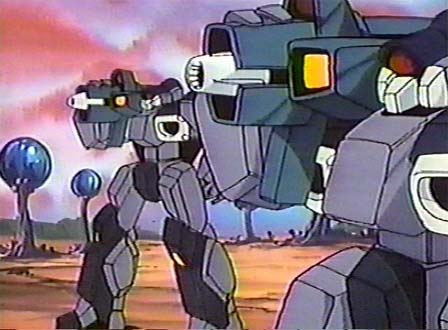 The VF-2 Vindicator was designed to replace the VF-4
"Lightning" as the primary close air support mecha for the REF marine
divisions. By 2017 the VF-4 "Lightning" had been in service for
6 years and was beginning to show its age against the much newer VF-6
"alpha" fighters. The Marine Aviation Wing clamored the REF high command for a new
close air support variable fighter using the latest Robotechnology. Military
engineers felt that the cheapest design which would meet the marines needs was
an upscale version of the VF-6 "alpha", which by 2017 was entering
final flight testing.
The VF-2 Vindicator was designed to replace the VF-4
"Lightning" as the primary close air support mecha for the REF marine
divisions. By 2017 the VF-4 "Lightning" had been in service for
6 years and was beginning to show its age against the much newer VF-6
"alpha" fighters. The Marine Aviation Wing clamored the REF high command for a new
close air support variable fighter using the latest Robotechnology. Military
engineers felt that the cheapest design which would meet the marines needs was
an upscale version of the VF-6 "alpha", which by 2017 was entering
final flight testing.
The VF-2A Vindicator was designed on an airframe 30% larger
than the standard VF-6. Two massive Pratt and Whitney RT-650 were mounted in either leg
providing 180 kN of thrust and two secondary Turbo Union ATF-410 are mounted in
the arms. Although, the engines themselves produce 40% more thrust than
the VF-6, the vindicator is not nearly as maneuverable and many alpha pilots
claim that piloting a Vindicator is just like piloting an alpha in a viscous
material. However, the VF-2 is able to distance itself against the alpha
in straight line flight with a top end speed of mach 3.3 at 18000m.
The flight control and cockpit control systems are similar
to that found on the VF-1 "Valkyrie" and VF-4 "Lightning".
This was done to minimize the amount of training necessary for Marine pilots to
qualify themselves in the VF-2; however, the side effect was the many of the
veterans of the First Robotech War found themselves more comfortable in the VF-2
than VF-6. Several of the older pilots in other services were able to
convince the high command to let them "borrow" VF-2 from the Marines.
The Vindciator's armor and weapons further separates itself
from the VF-6. The armor like all of the newer REF veritechs is a chobham composite designed to provide excellent protection
for most light and medium anti-mecha systems (up to 55mm cannons)
and fair protection for anything but direct strikes from heavy weaponry (120mm
cannons). Engineers estimated
that the VF-2A has almost 50% greater armor than the standard VF-6
"alpha". In addition to
the armor, the VF-2A has a MM-70 multi-missile system designed to fire standard
RDF short range missiles instead of the newer Hammer head short range
missiles. Engineers pressed for time were unable to mate the fire control
systems used on the VF-2 with the newer missile designs.
Production for the VF-2A started in 2019, but ceased after
575 units had been built in 2022. The REF high command decided that the expeditionary
force would launch with the weapons and warships that they had on hand. As
a result, the REF marines would continue to use the VF-4 lightning for an
additional 10 years. The production lines at that point switched over to
the VF-6 fighter for use in the Armies of the Southern Cross.
VF-2A units were thrown into the conflict with the Invid
immediately after the REF defolded over Tirol. Marine air wings flying
VF-2A's were some of the first units to come into conflict with Invid Inorganics
which were guarding several strategic areas around Tirol.
After the recapture of Tirol, the remaining Vindicators were divided up into 20
fighter wings and scattered throughout the Sentinel and REF force
structure. Generally, every Marine Division had at least 2
Vindicator fighter wings to provide close air support. Throughout the
early portion of the Sentinel Campaign, the Vindicator proved to be an extremely
durable unit suffering one of the lowest causality rates of all the VF mecha
types.
In 2027, the -B variant of the Vindicator was
introduced. Providing a substantial upgrade in the armor over the arms and
legs of the VF-2 and an improvement in the firing control system; pilots were
quick to adopt the newer model. By 2030 all 374 remaining Vindicators had
been upgraded. Perhaps
the most radical upgrade to the -B model was to the Vinicators weapon systems. The MM-70
missile system which was designed to fire older model RDF short range missiles
was replaced with the MM-96 multi-missile system. The MM-96 is similar in
all aspects to the MM-60 found on the Alpha; however, the larger frame of the
Vindicator allowed 36 additional hammerhead missiles to be stored
internally. The single problem with the newer variant, was that the
engines were not upgraded to handle the increased mass and as a result the top
end speed in all modes suffered. Perhaps the biggest improvement over the
VF-2A, was that the VF-2B could mount many of the older FAST pack spaceborne
boosters and hence increase its combat performance in space substantially. (See
Below)
By 2037, the Vindicator design was almost two decades old
and was beginning to show its wear. Many in the REF Marines wished that
the Block B models could be upgraded to a newer Block C with upgraded engines to
regain some of the maneuverability and lost speed.. However, all the
proposals were rejected by the REF Plenipotentiary council because of the high cost
of the upgrade. The entire fleet of Vindicators were placed in reserve on
Tirol in 2037.
The mothballing of the Vindicators proved to be short
lived, however. Six months later the first experimental protoculture
cloaking devices were built by the Robotech Research Groups. These first
cloaking devices were so bulky that only the Vindicators had sufficient internal
space to accommodate all of the new systems. Instead of modifying the
production VF-6 and VF-12 fighter, REF high command wanted shadow fighters as
soon as possible and decided to reactivate and modify most of the mothballed VF-2B fleet with
the new systems.
The new and final variant thus created was the -V model. In
addition to the MK-1 Shadow cloaking device the VF-2V was coated with a radar
absorbing material which reduced the fighter's radar cross section (see notes
below). Two P&W RT-660 fusion turbines were added to replace the
venerable RF-650 models which were originally installed with the VF-2A models
twenty years earlier. Upgraded armor was placed over the main body, arms,
and legs providing and additional 30% of protection. In addition, the older gun pods were replaced with a EU-12
destablizer. The EU-12 can fire 15 MJ bursts of particle energy.
Part of the EU-12 targeting system includes a spectral analyzer which then
"tune" the high energy electrons such that they will disrupt the force
field that the Vindicator is firing at. The system works against all force
fields, including Robotech Masters, Zentraedi, and Invid.
175 Vindicators were upgraded to the 'V' model and they
were immediately distributed throughout the fleet in squadrons of 12 with two or
three 'B' models for spare parts. The Vindicators were thus the
first shadow fighters to combat the Invid and as such they were highly
prized and jealously guarded by the REF marines. The units proved
themselves invaluable to the REF. Assault squadrons of Vindicators would
open up the exterior shield of Invid hives either to allow bombardment from
space or ground assaults from the planet. However, the role of the
Vindicator changed upon the introduction of the VF-9S "shadow-alpha"
and VF-12S "shadow-beta" by 2043. VF-2Vs were no longer the
supreme assault mecha and were relegated to opening breaches in the hive for
marine divisions. Some 100 VF-2Vs were present for the final assault on
Earth at the end of the Third Robotech War. Although, they managed to
break holes into the outer protoplex barrier surrounding Reflex point, all were
believed to have been destroyed in the initial assaults before the main fleet
gathered above Earth.
Service History:
-
-2A: 575 units produced from 2017 until 2019. Served
with the REF Marine Corp and in limited use with the REF Spacy from 2017
until all of the remaining 329 units were upgraded to the -2B model by
2025.
-2B: Upgraded model served exclusively with the REF Marine
Corp from 2025 until 2039. The remaining 175 units were upgraded to
the 2V model by 2039.
-2V: Served with the REF Marine Corps from 2037 until 2045.
RPG STATS
- Vehicle Type: VF-2 Vindicator
- Class: Variable Fighter
Manufacturer: Robotech
Expeditionary Forces
Crew: One pilot wearing Tactical Life Support System.
MDC BY LOCATION:
| Location |
VF-2A |
VF-2B |
VF-2V |
| *Head |
70 |
70 |
70 |
| Hands (2) |
40 |
40 |
40 |
| Forearm / Missile Pods (2) |
80 |
120 |
140 |
| Shoulder / Missile Pods |
100 |
100 |
120 |
| Upper Legs (2) |
100 |
100 |
125 |
| Lower Legs (2) |
150 |
150 |
175 |
| **Main Body |
400 |
425 |
425 |
| Pilots Compartment |
200 |
200 |
200 |
| Wings (2) |
150 |
150 |
150 |
| Tails (2) |
50 |
50 |
50 |
| EU-13 / GU-13 |
75 |
75 |
75 |
| Destablizer |
- |
- |
100 |
NOTES:
- *Destroying the sensor head of the VF-2 will knock out many of
the mecha's major sensor
systems, including all of the optics systems (infrared, nightvision, thermal). Radar and
communications will be unaffected.
- **Depleting the MDC of the main body will destroy the mecha.
SPEEDS:
- RUNNING, SOLDIER CONFIGURATION:
- 80 mph (128 kmph)
- LEAPING, SOLDIER CONFIGURATION:
- 100 ft (30 m) high or 300 ft (91.5 m) long without thrusters.
- FLYING, SOLDIER CONFIGURATION:
- (A,V) 400 mph 640 kph (A,V) /
- (B) 350 mph 560 kph for (B)
- FLYING, GERWALK CONFIGURATION:
- Mach One (670 mph/1072 kph) maximum speed limit in an Earth-like atmosphere. Can also
hover in place indefinitely.
- FLYING, FIGHTER CONFIGURATION:
- (A,V) Max level speed : 3537 kph at 18000m (Mach 3.3)
- (B) 3000 kph at 18000m (Mach 2.8)
1100 kph at sea level (Mach 1.0)
Stall speed : 182 kph (VTOL rectification possible)
Initial climb rate : over 20000m per minute
Service ceiling : 26 km (unboosted).
MAX ENGINE THRUST:
- 2 x Pratt & Whitney RT-650 [Main] Fusion plasma-air/reaction mass intermix
turbines. (A,B) Max thrust, 180 kN ea.
- 2 x Pratt & Whitney RT-660 [Main] Fusion plasma-air/reaction mass intermix
turbines. (V) Max thrust, 200 kN ea.
- 4 x Turbo-Union ATF 410 miniaturized fusion plasma-air/reaction mass intermix
ramjets. Two are mounted on the upper rear (jet mode), and two as
VTOL thrusters on the lower fuselage in place of the traditional head-turret [Auxiliary].
Each engine is rated to 56.9 kN standard thrust, max overboost to 101.1 kN each.
STATISTICAL DATA:
- HEIGHT:
- 14.0m in battloid configuration.
- 9.0m in guardian configuration.
- 6.7m in fighter configuration.
- WIDTH:
- 6.1m at shoulders in battloid
- 14.0m with wings at maximum extension in guardian and fighter
configuration.
- LENGTH:
- 7.32 m in battloid configuration.
- 14.3 m in guardian configuration.
- 15.7 m in fighter configuration.
- WEIGHT:
- 24,000 kg empty.
- PHYSICAL STRENGTH:
- Equal to a P.S. of 60
- CARGO:
- Small compartment behind pilot's seat for personal belongings in addition to the cyclone
storage compartment
- POWER PLANT:
- 2 x RTPS-4P Miniaturized Protoculture-cell energizer
- 32 standard canisters of Protoculture
1 dedicated canister for each EP-13/EU-13 gun pod
400 lit. D2O reactant for fusion engines.
- DELTA V:
- 100 kps for however two 35 kps tanks may be mounted on each hard point
- COMPATIBLE FAST PACKS:
- See Below
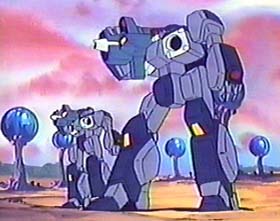
WEAPON SYSTEMS:
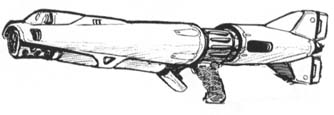 GU-111
65MM THREE-BARRELED SMOOTHBORE ROTARY: firing 700 rounds per minute,
600 round capacity stored internally. The GU-111 is an upgraded
version of the GU-11 used during the First Robotech War. The GU-111
was the standard weapon for the VF-2 until the introduction of the EU-12
destablizer in 2040.
GU-111
65MM THREE-BARRELED SMOOTHBORE ROTARY: firing 700 rounds per minute,
600 round capacity stored internally. The GU-111 is an upgraded
version of the GU-11 used during the First Robotech War. The GU-111
was the standard weapon for the VF-2 until the introduction of the EU-12
destablizer in 2040.
- PRIMARY PURPOSE: Assault
- SECONDARY PURPOSE: Anti-Mecha
- RANGE: Armor Piercing Spin Stabilized Discarding Sabot (APSSDS)
5249 feet (1600 m), or 3937ft (1200m) for all others.
- DAMAGE: APSSDS 6d6 short burst, 1D4*10+10 medium burst,
3D4*10+10 full melee burst. HEAP 1D4*10 short burst, 2D4*10
medium burst, 4D4*10 full melee burst. Tracer rounds reduce damage
by 25%. Standard 5d6 short burst, 1D4*10 medium burst, or 3D4*10
full melee burst
- RATE OF FIRE: Single shots or bursts equal to the combined
attacks of the pilot.
- PAYLOAD: 600 rounds of internal ammunition or 60 short bursts,
30 medium, or 15 full melee.
- NOTES: APSSDS critical strikes on 17,18,19,20.
HEAP critical strikes on 19,20. Tracers add +2 to strike.
-
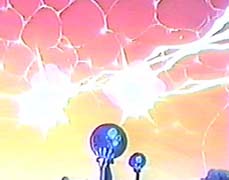 EU-12 DESTABLIZER (VF-2V): sub-nuclear particle beam gun with output of
15 MJ, can fire
up to 30 times/minute. Draws power from its own dedicated protoculture canister, but
can be fired using the veritech's own power. Particles have specific, disrupting
effect on force fields, and will short out a low power field completely, while high power
fields may temporarily and locally cease to function.
EU-12 DESTABLIZER (VF-2V): sub-nuclear particle beam gun with output of
15 MJ, can fire
up to 30 times/minute. Draws power from its own dedicated protoculture canister, but
can be fired using the veritech's own power. Particles have specific, disrupting
effect on force fields, and will short out a low power field completely, while high power
fields may temporarily and locally cease to function.
- PRIMARY PURPOSE: Anti-force Field
- SECONDARY PURPOSE: Anti-Mecha
- RANGE: 1800 m
- DAMAGE: 1D6*10 for each single shot
- RATE OF FIRE: Single shots equal to the combined attacks of the pilot up to eight
times per melee.
- PAYLOAD: Each protoculture cell can power up to 20 shots or
drawn directly from the main protoculture energizer for up to 4 shots
per melee
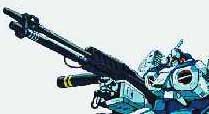
- (Optional) GA-15 40MM REF GAUSS RIFLE: See entry for GA-15
- PRIMARY PURPOSE: Assault
- SECONDARY PURPOSE: Anti-Mecha
- RANGE: 5.0 km
- DAMAGE: 2D4*10 for single shot
- RATE OF FIRE: The GA-15 fires up to 60 rounds per minute. The pilot can
fire as many single shots as his combined hand to hand attacks per melee
- PAYLOAD: 50 rounds stored internally.
- NOTES: -4 to strike within 500m
- (Optional) EP-13 THREE-BARRELED 80MM PARTICLE GUN POD: Can
fire 170 rounds per minute in full automatic mode, also capable of firing
all three barrels simultaneously in semiautomatic mode at approximately one
shot per second. This weapon fires 3.2 MJ pulses per barrel with its
own dedicated protoculture cell and capacitor banks in the 'clip'.
This weapon, built into an external shell identical to that of the GU-13,
was developed in 2032 by the REF, but did not see wide use until 2037.
Some pilots preferred the newer EP-13 over the standard GU-111 and had their
combat engineers redesign the weapon so that the larger VF-2 could use the
EP-13.
- PRIMARY PURPOSE: Assault
- SECONDARY PURPOSE: Anti-Mecha
- RANGE: 1200 m
- DAMAGE: 2D4 for each Single blast, 1D6*10 for each triple
blast, 2D4*10 for each medium burst (up to six times per melee), or
4D4*10 for each full melee burst.
- RATE OF FIRE: Single shots or bursts equal to the combined
attacks of the pilot.
- PAYLOAD: Conditionally unlimited. The protoculture cell
is estimated to have enough power for 3000 single shots, 1000 triple
shots, 300 medium bursts, or 100 full melee bursts.
- RRG MK-10 NOSE LASERS: Like the original VF-1 the Alpha fighter has two nose lasers
on either side of the pilot's compartment. Each laser can fire 7 MJ
bursts of laser energy up to 60 times per minute. The lasers are
powered directly by the main protoculture generators and may only be fired
in fighter mode.
- PRIMARY PURPOSE: Assault/Defense
- SECONDARY PURPOSE: Anti-mecha
- RANGE: 1500 m
- DAMAGE: 1D6*10 for each single shot
- RATE OF FIRE: Equal to the combine attacks of the pilot
- PAYLOAD: Unlimited
- MM-70 MULTI-MISSILE SYSTEM (VF-2A): The original missile armament
for the VF-2 included 70
onboard RDF short range missiles. This system was replaced in later
models with the more advanced MM-96 system which used the standard REF
Hammerheads. .
- PRIMARY PURPOSE: Assault/Defense
- SECONDARY PURPOSE: Anti-mecha
- RANGE: Varies
- DAMAGE: Varies
- RATE OF FIRE: One at a time or in volleys of two, four, eight, sixteen,
thirty-two,
or all 70
- PAYLOAD: 12 Lower Arms, 10 Shoulders, 13 Lower Legs
- MM-96 MULTI-MISSILE SYSTEM (VF-2B,2V): The VF-2V has upgraded
its standard MM-70 multi-missile system which uses standard RDF short range
missiles to the MM-96 which uses more compact REF hammerhead short range
missiles. As a result, an additional 26 missiles are stored internally
in virtually the same amount on internal space.
- PRIMARY PURPOSE: Assault/Defense
- SECONDARY PURPOSE: Anti-mecha
- RANGE: Varies
- DAMAGE: Varies
- RATE OF FIRE: One at a time or in volleys of two, four, eight, sixteen,
thirty-two, sixy-four, or all 96
- PAYLOAD: 16 Lower Arms, 14 Shoulders, 18 Lower Legs
- (Optional) MM-16 MULTI-MISSILE SYSTEM: 16 hammerhead missiles can be stored in an optional
launcher between the two arms in fighter mode. Theses missiles must be fired before
the Vindicator can transform
- PRIMARY PURPOSE: Assault/Defense
- SECONDARY PURPOSE: Anti-mecha
- RANGE: Varies
- DAMAGE: Varies
- RATE OF FIRE: One at a time or in volleys of two, four, eight, or all sixteen.
- PAYLOAD: 16 short range missiles
- (All) DDI-8 MEDIUM RANGE MISSILE SYSTEM: Eight 260mm x 1.2m Diamondback
medium range missiles can be
stored under the intakes.
- PRIMARY PURPOSE: Assault/Defense
- SECONDARY PURPOSE: Anti-mecha
- RANGE: Varies
- DAMAGE: Varies (Typically 2D6*10)
- RATE OF FIRE: One at a time or in volleys of two, three, four,
six, or all eight
- PAYLOAD: 4 in each intake for a total of 8
- NOTE: GM's may allow players to use any standard Palladium medium
range missile instead of Diamondback missiles.
- BODY/WING HARD POINTS: Four fixed hard points are mounted on each wing.
These hardpoints can be used to carry 15 short range missiles, 5 medium range
missiles or 2
long range missiles.
- HAND TO HAND COMBAT: If necessary, the Vindicator can engage in melee combat rather
than use a weapon. The VF-2 is extremely agile and can execute most typical hand to
hand combat moves, such as punches, jump kicks, leap attacks, rolling with impacts, etc.
DAMAGE:
- Punch in Battloid: 2D4*3
- Punch in Guardian: 1D6*3
- Kick: 2D6*3
- Leap Kick: 3D6*3
- Body Flip/Throw: 1D4*3
- Body Block/Tackle: 2D6*3
- Stomp: 1D4*3 . (only effective against small objects)
FAST PACKS FOR VF-2 (B,V):
History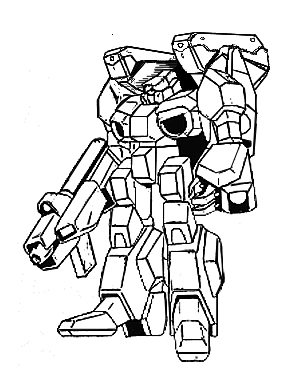
The VF-2B was upgraded to allow the addition of FAST packs for use in
spaceborne applications. Although the FAST packs would would hinder
atmospheric maneuverability, in space they transformed the VF-2B into a deadly
foe providing additional combat capability as well as providing additional fuel
for deep space operations.
At the time, the VF-12 "Beta" was still in development and thus the
VF-2B became highly prized by the REF SPACY lacking at the time a long range
combat veritech. Although, the Marines were hesitant to release any of
their prized Vindicators, six REF SPACY squadrons were formed. These
squadrons would act independently of the main fleet often scouting ahead of the
main combat forces into asteroid belts or small moons. These six squadrons
had some of the highest kill rates for the entire REF fighter force.
Despite the success with the VF-2 Vindicator, they were all upgraded to the
newer VF-12 "Beta" by 2039. After which point, only the REF
marine fighter wings would fly the VF-2. Although, the VF-2V could also
operate with FAST packs, they rarely did so. This was mainly due to the
fact that they were operating primary in their original role of ground support
and did not need to operate in space.
Statistical Data:
- (Standard) NP-BP-10: First produced in 2025 as an upgrade
for the venerable
 NP-BP-01 booster, the -10 in its outward appearance looks similar to its predecessor.
However, both the main engine and missile launchers have been substantially
upgraded. The -10 mounts a single HMMP-04 missile launcher with an
internal payload of 27 Hammerhead REF short range missiles, an increase of
15 missiles over the older HMMP-02 system. Likewise the main fusion
turbine has been upgraded to the EF-2020 model producing a maximum thrust of
1400 kN.
NP-BP-01 booster, the -10 in its outward appearance looks similar to its predecessor.
However, both the main engine and missile launchers have been substantially
upgraded. The -10 mounts a single HMMP-04 missile launcher with an
internal payload of 27 Hammerhead REF short range missiles, an increase of
15 missiles over the older HMMP-02 system. Likewise the main fusion
turbine has been upgraded to the EF-2020 model producing a maximum thrust of
1400 kN.
- MDC: 170
- MAIN ENGINE: EF-2010 Fusion Turbine with a maximum thrust
of 1400 kN
- DELTA V: 65 kps
- PRIMARY WEAPONRY: HMMP-04 Missile Launcher
- RANGE: Varies, Typically 10 kilometers
- DAMAGE: 1D6*10
- PAYLOAD: 27 Hammerhead REF short range missiles
- RATE OF FIRE: Volleys of 1 to 9 missiles

- (Optional) NP-BP-01: First produced in 2011 for the VF-1,
the NP-BP-01 booster became standard FAST pack for all VF-1 spaceborne
operations throughout the end of the First Robotech War. Although,
outclassed by later models, a number of NP-BP-01 were taken by the REF for
use on older VF-1 and VF-4 fighters. If necessary, the VF-2 can mount
the older system instead of the newer, and preferred, -10 model.
- MDC: 150
- MAIN ENGINE: EF-2001 Fusion Turbine with a maximum thrust
of 1180 kN
- DELTA V: 50 kps
- PRIMARY WEAPONRY: HMMP-02 Missile Launcher
- RANGE: 10 kilometers
- DAMAGE: 1D6*10
- PAYLOAD: Twelve RDF Starburst short range missiles
- RATE OF FIRE: One at a time or in volleys of two, three or
four

- (Optional) NP-BP-02: Designed shortly after the NP-BP-01
booster, the -02 model was never produced in great quantities. The -02
model is identical in all regards to the -01 except that the HMMP-02 missile
system was replaced with two Ro-X24 particle beam cannons. The cannons
proved difficult to manufacture in quantity and thus only the flight
commanders and veritech aces were ever issued -02 for their mecha and then
only one at a time. VF-1 fighters which mounted a one -02 and one -01
FAST pack were called "Strike" valkyries to distinguish them from
those which mounted two -02 FAST packs (or "Super" valkyries).
Most of the remaining -02 models were brought with the REF into deep space
and can be mounted on the VF-2.
- MAIN ENGINE: EF-2001 Fusion Turbine with a maximum thrust
of 1180 kN
- DELTA V: 50 kps
- PRIMARY WEAPONRY: Ro-X24 Particle Beam Cannon firing 10
MJ of particle beam energy up to 30 times per minute.
- RANGE: 2 kilometers
- DAMAGE: 1D4*10 per cannon (two Ro-X24 cannons are mounted)
- PAYLOAD: Effectively unlimited
- RATE OF FIRE: Up to seven times per melee per cannon
- NOTES: +1 to strike
STANDARD EQUIPMENT FOR THE VF-2:
- AUTO-PILOT: The VF-2 is equipped with a computerized auto-pilot, allowing the
pilot to relax or even sleep during long voyages. The auto- pilot can be programmed with a
single destination or a complex flight plan involving multiple speeds, directions, and
destinations. The onboard computer will alert the pilot when the fighter is near its
destination, and can also be set to automatically signal when sensors detect objects near
the mecha. The auto-pilot was designed with long intra-system space journeys in mind.
- COMBAT COMPUTER: The combat computer tracks and identifies specific enemy
targets, and has a database of over 10,000 images stored in memory. The computer can
identify and track up to 250 targets simultaneously.
- ELETTRONICA RADAR WARNING RECEIVER (RWR)
- OLDELFT INFRA-RED WARNING RECEIVER (IRWR)
- WESTINGHOUSE ALQ-250(V) ACTIVE SENSOR JAMMER: internal ECM
- EXTERNAL AUDIO PICKUP: Range: 300 ft (91.5 m). A sound amplification system that
can pick up normal conversation up to 300 feet away.
- HEAT AND RADIATION SHIELDS: Special shielding prevents the penetration of life
threatening head and radiation. A radiation detection and alarm system are linked with the
shields and will sound an alarm if there is a rupture in the shields and what the levels
of radiation are.
- HOMING SIGNAL: The escape pod of the VF-2 is equipped with a homing
device that enables rescue teams to locate a disabled craft or ejected life pod. The range
of the signal is 400 miles (640 km). Most REF ships and veritechs can locate and track a
homing signal, and the onboard computers will automatically notify their pilots if such a
signal is detected.
- LASER TARGETING SYSTEM: Range: 100 miles (160 km). Used for increased accuracy in
the striking of enemy targets and is partly responsible for the mecha's strike bonus.
- LOUDSPEAKER: A loudspeaker system is built into the craft, which can be used to
amplify the pilot's voice up to 90 decibels.
- OPTICS: INFRARED: Range: 2000 feet (610 m). This optical system projects a beam
of infrared light that is invisible to the normal eye, but detectable by the mecha's
sensors. The system allows the pilot to detect hidden/concealed objects by their IR
reflectiveness. The beam will be visible to anyone with IR sensitive optics, however.
- OPTICS: NIGHTVISION: Range: 2000 feet (610 m). A passive light image intensifier
that emits no light of its own, but relies on ambient light which is electronically
amplified to produce a visible picture.
- OPTICS: THERMAL IMAGER: Range: 2000 feet (610 m). A passive optical heat sensor
that detects infrared radiation projected by warm objects and converts that data into a
false-color visible image. The system enables the pilot to see in the dark, in shadows,
and through smoke, and also adds a +10% bonus to pilots using a tracking skill.
- RADAR: 100 mile range.
- RADIO/VIDEO COMMUNICATION: Long range, directional communications system with
satellite relay capabilities. Range: 600 miles (960 km) or can be boosted indefinitely via
satellite relay.
- SELF-DESTRUCT: To prevent capture of an advance variable fighter by the enemy,
the pilot can activate the VF-2 self-destruct system, which will cause the fighter
to explode after a delay of up to 60 minutes (time is set by the pilot). The explosive
damage is contained within a 20 foot (6 m) area and inflicts 1D6x10 M.D. to everything
within the radius of the explosion. All internal systems are obliterated. The escape pod
will be automatically ejected prior to the explosion unless the pilot overrides the
ejection sequence.
- STANDARD SURVIVAL KIT: All REF veritechs come equipped with a portable survival
kit. Inside the small reinforced box is a medium-sized flashlight, two hand flares, one
rocket flare, a compass, infrared distancing binoculars, a small mirror, a pocket knife,
dehydrated and concentrated food (can be stretched into a five day supply for one person)
and basic first aid items (aspirin, bandages, disinfectants, etc.)
- TACTICAL LIFE SUPPORT SYSTEM: The VF-2 cockpit is pressurized, and also provides
additional air feeds to the pilot's flight suit that provides him with pressurized
breathing. The REF flight suit also contains an upper and lower g-suit that promotes blood
circulation even during high-g turns, thus decreasing the possibility of pilot's blacking
out in combat.
- CHAFF AND FLARE DISPENSERS: 36 chaff and 36 flares are stored in
each of the
lower legs
- SMOKE DISPENSERS
STANDARD EQUIPMENT FOR THE VF-2V:
- RRG MK1 SHADOW: four-dimensional distortion field generator (downshifts
and dampens protoculture radiation) emitting only weakly in these wavebands.
NOTE: . Once the mecha has lost three/fourths of its main body MDC, there is a 50% chance that the
stealth system will fail every time the main body of the craft is hit. Once the stealth
system has failed, it will not work again until repaired at a RDF base.
- RRG MK2 EM-ABSORBING SKIN COVER: strongly absorbing EM radiation from
radio through ultra-violet wavelengths, and emitting only weakly in these bandwidths.
Reduce radar acquisition by 75%
- TEXAS INSTRUMENTS APG-137 SYNTHETIC APERTURE RADAR: (200 mile range)
COMBAT BONUSES FOR VINDICATOR COMBAT TRAINING:
- 2 attacks per melee (plus those of the pilot).
- Add one additional action/attack at levels six and eleven.
- +3 on initiative (V)
- +1 to strike (A) / +2 to strike (B) / +3 strike (V)
- +2 to parry
- +2 to dodge in solder, +4 guardian, +6 in jet mode.
- +3 to roll with a punch or fall with an impact, reducing damage by half.
- Critical strike same as pilot's hand-to-hand.
COMBAT BONUSES FOR VINDICATOR BASIC COMBAT TRAINING:
- 1 attacks per melee (plus those of the pilot).
- Add one additional action/attack at levels seven and thirteen
- +0 to strike / +1 strike (V)
- +1 to parry
- +1 to dodge in solder, +2 guardian, +3 in jet mode.
- +2 to roll with a punch or fall with an impact, reducing damage by half.
- Critical strike same as pilot's hand-to-hand.
Random Hit Locations
When there is an equal chance of hitting both sides from 1d6
- 1-3 hits the right side
- 4-6 hits the left
When there is a preferred side, roll 1d10
- 1-8 hits the preferred side
- 9-10 hits the opposite side
| Vindicator Fighter |
FRONT |
BACK |
SIDES |
TOP |
BOTTOM |
| Head (Main Body) |
01-03 |
- |
01-02 |
- |
01-04 |
| Hands (Forearms) |
- |
01-03 |
- |
- |
- |
| Forearms (Shoulders) |
04-09 |
04-30 |
03-20 |
01-20 |
- |
| Shoulders (Main Body) |
10-35 |
31-35 |
21-35 |
21-30 |
- |
| Upper Legs (Main Body) |
36-45 |
36-40 |
36-45 |
- |
05-14 |
| Lower Legs (Upper
Legs) |
46-50 |
41-60 |
46-60 |
- |
15-34 |
| Wings (Main Body) |
51-55 |
61-65 |
61-65 |
31-55 |
35-59 |
| Tail (Main Body) |
56-60 |
66-70 |
66-75 |
56-59 |
- |
| Main Body |
61-70 |
71-85 |
76-80 |
60-75 |
60-75 |
| Pilot's Compartment |
71-95 |
86-95 |
81-95 |
76-00 |
76-95 |
| Gun Pod (Hands) |
96-00 |
96-00 |
96-00 |
- |
96-00 |
| Vindicator Guardian |
FRONT |
BACK |
SIDES |
TOP |
BOTTOM |
| Head (Main Body) |
01 |
01-03 |
01-03 |
- |
01-05 |
| Hands (Forearms) |
02-05 |
- |
04-08 |
01-02 |
06-09 |
| Forearms (Shoulders) |
06-14 |
04-19 |
09-25 |
03-12 |
10-25 |
| Shoulders (Main Body) |
15-21 |
20-30 |
26-38 |
13-22 |
26-35 |
| Upper Legs (Main Body) |
22-30 |
31-40 |
39-42 |
23-27 |
36-40 |
| Lower Legs (Upper
Legs) |
31-45 |
41-61 |
43-60 |
28-31 |
41-65 |
| Wings (Main Body) |
46-50 |
62-68 |
61-70 |
32-33 |
66-69 |
| Tail (Main Body) |
- |
- |
- |
- |
- |
| Main Body |
51-75 |
69-89 |
71-75 |
34-70 |
70-79 |
| Pilot's Compartment |
76-95 |
90-95 |
76-95 |
71-95 |
80-95 |
| Gun Pod (Hands) |
96-00 |
96-00 |
96-00 |
96-00 |
96-00 |
| Vindicator Battloid |
FRONT |
BACK |
SIDES |
TOP |
BOTTOM |
| Head (Main Body) |
01-04 |
01-04 |
01-04 |
01-14 |
- |
| Hands (Forearms) |
05-08 |
05-08 |
05-08 |
15-20 |
01-05 |
| Forearms (Shoulders) |
09-20 |
09-20 |
09-23 |
21-29 |
06-20 |
| Shoulders (Main Body) |
21-27 |
21-27 |
24-37 |
30-39 |
21-23 |
| Upper Legs (Main Body) |
28-35 |
28-35 |
38-42 |
- |
24-27 |
| Lower Legs (Upper
Legs) |
36-61 |
36-61 |
43-63 |
40-44 |
28-65 |
| Wings (Main Body) |
- |
62-72 |
64-68 |
45-47 |
66-69 |
| Tail (Main Body) |
- |
- |
- |
- |
- |
| Main Body |
62-92 |
73-85 |
69-93 |
48-91 |
70-84 |
| Pilot's Compartment |
93-94 |
86-96 |
94-94 |
92-95 |
85-91 |
| Gun Pod (Hands) |
95-00 |
97-00 |
95-00 |
96-00 |
92-00 |
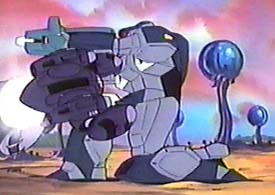 REFERENCES USED IN THIS DESIGN
REFERENCES USED IN THIS DESIGN
- Robotech Technical Files: Veritech Alpha Fighter VAF-6
- Robotech Technical Files: VF-1 "Valkyrie"
- Palladium Books: "The Sentinels"
Back to Mecha Home
 The VF-2 Vindicator was designed to replace the VF-4
"Lightning" as the primary close air support mecha for the REF marine
divisions. By 2017 the VF-4 "Lightning" had been in service for
6 years and was beginning to show its age against the much newer VF-6
"alpha" fighters. The Marine Aviation Wing clamored the REF high command for a new
close air support variable fighter using the latest Robotechnology. Military
engineers felt that the cheapest design which would meet the marines needs was
an upscale version of the VF-6 "alpha", which by 2017 was entering
final flight testing.
The VF-2 Vindicator was designed to replace the VF-4
"Lightning" as the primary close air support mecha for the REF marine
divisions. By 2017 the VF-4 "Lightning" had been in service for
6 years and was beginning to show its age against the much newer VF-6
"alpha" fighters. The Marine Aviation Wing clamored the REF high command for a new
close air support variable fighter using the latest Robotechnology. Military
engineers felt that the cheapest design which would meet the marines needs was
an upscale version of the VF-6 "alpha", which by 2017 was entering
final flight testing. 
 GU-111
65MM THREE-BARRELED SMOOTHBORE ROTARY
GU-111
65MM THREE-BARRELED SMOOTHBORE ROTARY EU-12 DESTABLIZER (VF-2V): sub-nuclear particle beam gun with output of
15 MJ, can fire
up to 30 times/minute. Draws power from its own dedicated protoculture canister, but
can be fired using the veritech's own power. Particles have specific, disrupting
effect on force fields, and will short out a low power field completely, while high power
fields may temporarily and locally cease to function.
EU-12 DESTABLIZER (VF-2V): sub-nuclear particle beam gun with output of
15 MJ, can fire
up to 30 times/minute. Draws power from its own dedicated protoculture canister, but
can be fired using the veritech's own power. Particles have specific, disrupting
effect on force fields, and will short out a low power field completely, while high power
fields may temporarily and locally cease to function.

 NP-BP-01 booster, the -10 in its outward appearance looks similar to its predecessor.
However, both the main engine and missile launchers have been substantially
upgraded. The -10 mounts a single HMMP-04 missile launcher with an
internal payload of 27 Hammerhead REF short range missiles, an increase of
15 missiles over the older HMMP-02 system. Likewise the main fusion
turbine has been upgraded to the EF-2020 model producing a maximum thrust of
1400 kN.
NP-BP-01 booster, the -10 in its outward appearance looks similar to its predecessor.
However, both the main engine and missile launchers have been substantially
upgraded. The -10 mounts a single HMMP-04 missile launcher with an
internal payload of 27 Hammerhead REF short range missiles, an increase of
15 missiles over the older HMMP-02 system. Likewise the main fusion
turbine has been upgraded to the EF-2020 model producing a maximum thrust of
1400 kN.

 REFERENCES USED IN THIS DESIGN
REFERENCES USED IN THIS DESIGN